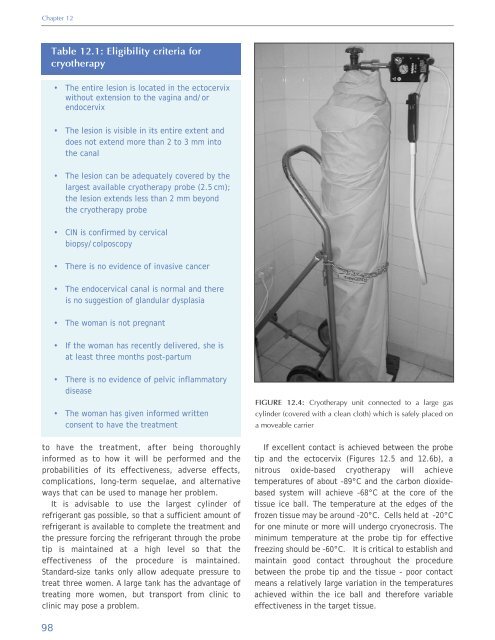Colposcopy and Treatment of Cervical Intraepithelial Neoplasia - RHO
Colposcopy and Treatment of Cervical Intraepithelial Neoplasia - RHO
Colposcopy and Treatment of Cervical Intraepithelial Neoplasia - RHO
Create successful ePaper yourself
Turn your PDF publications into a flip-book with our unique Google optimized e-Paper software.
Chapter 12<br />
Table 12.1: Eligibility criteria for<br />
cryotherapy<br />
• The entire lesion is located in the ectocervix<br />
without extension to the vagina <strong>and</strong>/or<br />
endocervix<br />
• The lesion is visible in its entire extent <strong>and</strong><br />
does not extend more than 2 to 3 mm into<br />
the canal<br />
• The lesion can be adequately covered by the<br />
largest available cryotherapy probe (2.5 cm);<br />
the lesion extends less than 2 mm beyond<br />
the cryotherapy probe<br />
• CIN is confirmed by cervical<br />
biopsy/colposcopy<br />
• There is no evidence <strong>of</strong> invasive cancer<br />
• The endocervical canal is normal <strong>and</strong> there<br />
is no suggestion <strong>of</strong> gl<strong>and</strong>ular dysplasia<br />
• The woman is not pregnant<br />
• If the woman has recently delivered, she is<br />
at least three months post-partum<br />
• There is no evidence <strong>of</strong> pelvic inflammatory<br />
disease<br />
• The woman has given informed written<br />
consent to have the treatment<br />
to have the treatment, after being thoroughly<br />
informed as to how it will be performed <strong>and</strong> the<br />
probabilities <strong>of</strong> its effectiveness, adverse effects,<br />
complications, long-term sequelae, <strong>and</strong> alternative<br />
ways that can be used to manage her problem.<br />
It is advisable to use the largest cylinder <strong>of</strong><br />
refrigerant gas possible, so that a sufficient amount <strong>of</strong><br />
refrigerant is available to complete the treatment <strong>and</strong><br />
the pressure forcing the refrigerant through the probe<br />
tip is maintained at a high level so that the<br />
effectiveness <strong>of</strong> the procedure is maintained.<br />
St<strong>and</strong>ard-size tanks only allow adequate pressure to<br />
treat three women. A large tank has the advantage <strong>of</strong><br />
treating more women, but transport from clinic to<br />
clinic may pose a problem.<br />
FIGURE 12.4: Cryotherapy unit connected to a large gas<br />
cylinder (covered with a clean cloth) which is safely placed on<br />
a moveable carrier<br />
If excellent contact is achieved between the probe<br />
tip <strong>and</strong> the ectocervix (Figures 12.5 <strong>and</strong> 12.6b), a<br />
nitrous oxide-based cryotherapy will achieve<br />
temperatures <strong>of</strong> about -89°C <strong>and</strong> the carbon dioxidebased<br />
system will achieve –68°C at the core <strong>of</strong> the<br />
tissue ice ball. The temperature at the edges <strong>of</strong> the<br />
frozen tissue may be around –20°C. Cells held at –20°C<br />
for one minute or more will undergo cryonecrosis. The<br />
minimum temperature at the probe tip for effective<br />
freezing should be –60°C. It is critical to establish <strong>and</strong><br />
maintain good contact throughout the procedure<br />
between the probe tip <strong>and</strong> the tissue - poor contact<br />
means a relatively large variation in the temperatures<br />
achieved within the ice ball <strong>and</strong> therefore variable<br />
effectiveness in the target tissue.<br />
98
















